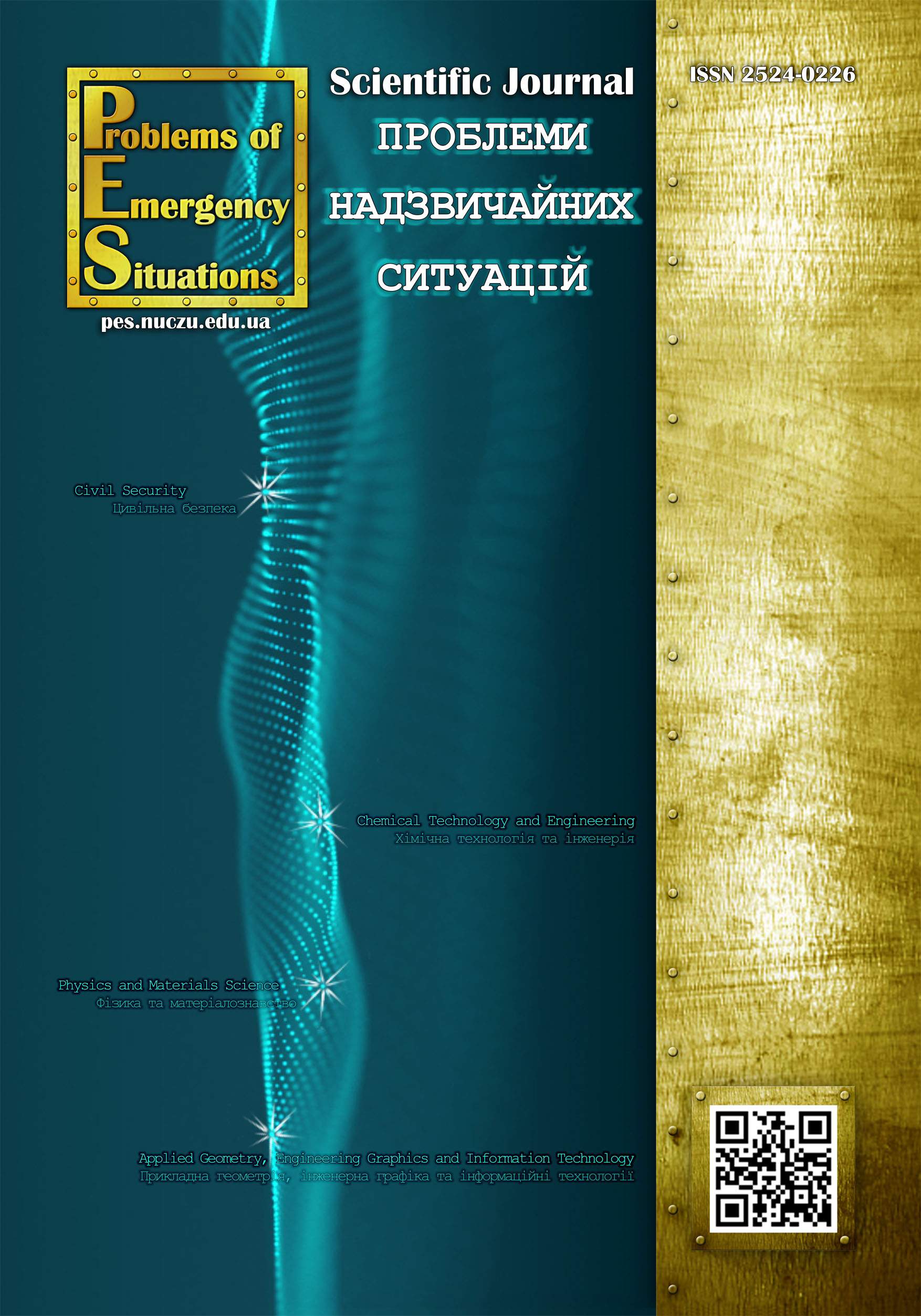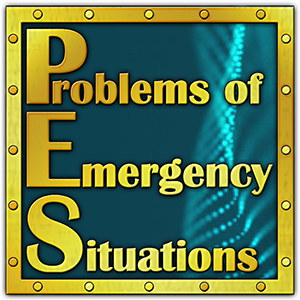Improving the safety level of robots and manipulators
Tsymbal Bohdan
National University of Civil Protection of Ukraine
http://orcid.org/0000-0002-2317-3428
Rybka Evgeniy
National University of Civil Protection of Ukraine
http://orcid.org/0000-0002-5396-5151
Svirzhevskyi Petro
National University of Civil Protection of Ukraine
https://orcid.org/0009-0004-2463-5841
Rybalova Olga
National University of Civil Protection of Ukraine
http://orcid.org/0000-0002-8798-4780
Petryshchev Artem
National University «Zaporizhzhya Polytechnic»
http://orcid.org/0000-0003-2631-1723
DOI: https://doi.org/10.52363/2524-0226-2025-41-1
Keywords: occupational risks, occupational safety, cobots, robots, manipulators, artificial intelligence
Аnnotation
The research focuses on developing a methodology to improve the safety of robots and manipulators in industrial environments. Robotic systems effectively perform complex and dangerous tasks, but at the same time create new risks for workers, which requires systematic assessment and management. An analysis of the main factors affecting the safety of robotic systems was conducted, in particular mechanical, ergonomic, thermal and electrical hazards. Based on this, a universal methodology for assessing occupational risks was developed, which takes into account the severity of possible injuries, the probability of their occurrence, personnel qualifications, the speed of danger onset and the level of awareness of workers. The methodology includes developed checklists, risk assessment matrices and questionnaires for identifying hazardous factors and determining the level of risks. To verify its effectiveness, a test was conducted at a machine-building enterprise, where the risks for employees working with the Absolute Arm 7-Axis measuring arm, the GLOBAL S GREEN 05.07.05 coordinate measuring machine and the ABB IRB 1400 M94A welding robot were assessed. It was found that the most dangerous workplace is the workplace of the ABB IRB 1400 M94A welding robot operator, because he is faced with mechanical, thermal, electrical, ergonomic, combined hazards and radiation hazards, the most important is the risk when the operator contacts live parts or connections, which is 51 (significant). The results showed the key risks at the workplaces, as well as the effectiveness of the developed measures to minimize them. Personnel training, restriction of access to hazardous areas and the use of personal protective equipment were introduced. The methodology can be applied to identify risks and implement safety measures at enterprises in various industries.
References
- Gihleb, R., Giuntella, O., Stella, L., Wang, T. (2022). Industrial robots, workers’ safety, and health. Labour Economics, 78, 102205. doi: 10.1016/j.labeco.2022.102205
- Caiazzo, C., Nestić, S., Savković, M. (2022). A systematic classification of key performance indicators in human-robot collaboration. In Sustainable business management and digital transformation: Challenges and opportunities in the post-covid era, 479–489. Springer International Publishing. doi: 10.1007/978-3-031-18645-5_30
- Yetkin, B. N., Ulutas, B. H. (2022). A Literature Review on Human-robot Collaborative Environments Considering Ergonomics. In Lecture Notes in Management and Industrial Engineering, 49–60. Springer International Publishing. doi: 10.1007/978-3-031-08782-0_5
- Hashemi-Petroodi, S. E., Thevenin, S., Kovalev, S., Dolgui, A. (2020). Operations management issues in design and control of hybrid human-robot collaborative manufacturing systems: A survey. Annual Reviews in Control, 49, 264–276. doi: 10.1016/j.arcontrol.2020.04.009
- Gualtieri, L., Rauch, E., Vidoni, R. (2021). Emerging research fields in safety and ergonomics in industrial collaborative robotics: A systematic literature review. Robotics and Computer-Integrated Manufacturing, 67, 101998. doi: 10.1016/j.rcim.2020.101998
- Olsen, T. L., Tomlin, B. (2020). Industry 4.0: Opportunities and challenges for operations management. Manufacturing & Service Operations Management, 22(1), 113–122. doi: 10.1287/msom.2019.0796
- Colim, A., Faria, C., Cunha, J., Oliveira, J., Sousa, N., Rocha, L. A. (2021). Physical ergonomic improvement and safe design of an assembly workstation through collaborative robotics. Safety, 7(1), 14. doi: 10.3390/safety7010014
- Gualtieri, L., Rauch, E., Vidoni, R., Matt, D. T. (2020). Safety, ergonomics and efficiency in human-robot collaborative assembly: Design guidelines and requirements. Procedia CIRP, 91, 367–372. doi: 10.1016/j.procir.2020.02.188
- Kim, W., Peternel, L., Lorenzini, M., Babič, J., Ajoudani, A. (2021). A human-robot collaboration framework for improving ergonomics during dexterous operation of power tools. Robotics and Computer-Integrated Manufacturing, 68, 102084. doi: 10.1016/j.rcim.2020.102084
- Chutima, P. (2020). Research trends and outlooks in assembly line balancing problems. Engineering Journal, 24(5), 93–134. doi: 10.4186/ej.2020.24.5.93
- Weckenborg, C., Kieckhäfer, K., Müller, C., Grunewald, M., Spengler, T. S. (2019). Balancing of assembly lines with collaborative robots. Business Research, 13(1), 93–132. doi: 10.1007/s40685-019-0101-y
- Pinheiro, S., Correia Simões, A., Pinto, A., Van Acker, B. B., Bombeke, K., Romero, D., Vaz, M., Santos, J. (2021). Ergonomics and safety in the design of industrial collaborative robotics. In Studies in systems, decision and control. Springer International Publishing, 465–478. doi: 10.1007/978-3-030-89617-1_42
- Srivatsan, H., Myagerimath, A. V., Duffy, V. G. (2024). A systematic review of collaborative robots in ergonomics. In Digital human modeling and applications in health, safety, ergonomics and risk management, 282–297. Springer Nature Switzerland. doi: 10.1007/978-3-031-61066-0_17
- Lorenzini, M., Lagomarsino, M., Fortini, L., Gholami, S., Ajoudani, A. (2023). Ergonomic human-robot collaboration in industry: A review. Frontiers in Robotics and AI, 9. doi: 10.3389/frobt.2022.813907
- Salvendy, G., Karwowski, W. (2021). Handbook of human factors and ergonomics. Wiley. doi: 10.1002/9781119636113
- Adriaensen, A., Costantino, F., Di Gravio, G., Patriarca, R. (2021). Teaming with industrial cobots: A socio‐technical perspective on safety analysis. Human Factors and Ergonomics in Manufacturing & Service Industries, 32(2), 173–198. doi: 10.1002/hfm.20939
- Martinetti, A., Chemweno, P. K., Nizamis, K., Fosch-Villaronga, E. (2021). Redefining safety in light of human-robot interaction: A critical review of current standards and regulations. Frontiers in Chemical Engineering, 3. doi: 10.3389/fceng.2021.666237
- Michalos, G., Karagiannis, P., Dimitropoulos, N., Andronas, D., Makris, S. (2021). Human robot collaboration in industrial environments. In The 21st century industrial robot: When tools become collaborators, 17–39. Springer International Publishing. doi: 10.1007/978-3-030-78513-0_2
- Makris, S., Michalos, G., Dimitropoulos, N., Krueger, J., Haninger, K. (2024). Seamless human–robot collaboration in industrial applications. In Lecture notes in mechanical engineering, 39–73. Springer Nature Switzerland. doi: 10.1007/978-3-031-54034-9_2
- Colim, A., Carneiro, P., Costa, N., Faria, C., Rocha, L., Sousa, N., Silva, M., Braga, A. C., Bicho, E., Monteiro, S., Arezes, P. M. (2020). Human-Centered approach for the design of a collaborative robotics workstation. In Occupational and environmental safety and health II, 379–387. Springer International Publishing. doi: 10.1007/978-3-030-41486-3_41
- Kopp, T., Baumgartner, M., Kinkel, S. (2020). Success factors for introducing industrial human-robot interaction in practice: An empirically driven framework. The International Journal of Advanced Manufacturing Technology. doi: 10.1007/s00170-020-06398-0
- Keshvarparast, A., Battini, D., Battaia, O., Pirayesh, A. (2024). Collaborative robots in manufacturing and assembly systems: Literature review and future research agenda. Journal of Intelligent Manufacturing, 35, 2065–2118. doi: 10.1007/s10845-023-02137-w
- Duan, J., Zhuang, L., Zhang, Q., Zhou, Y., Qin, J. (2024). Multimodal perception-fusion-control and human–robot collaboration in manufacturing: A review. The International Journal of Advanced Manufacturing Technology. doi: 10.1007/s00170-024-13385-2
- Martinetti, A., Chemweno, P. K., Nizamis, K., Fosch-Villaronga, E. (2021). Redefining safety in light of human-robot interaction: A critical review of current standards and regulations. Frontiers in Chemical Engineering, 3. doi: 10.3389/fceng.2021.666237
- Keeping workers safe in the automation revolution. (n.d.). Brookings. Available at: https://www.brookings.edu/articles/keeping-workers-safe-in-the-automation-revolution/
- Liang, C.-J., Cheng, M. H. (2023). Trends in robotics research in occupational safety and health: A scientometric analysis and review. International Journal of Environmental Research and Public Health, 20(10), 5904. doi: 10.3390/ijerph20105904
- Valori, M., Prange-Lasonder, G., Saenz, J., Behrens, R., Bidard, C., Lucet, E., Fassi, I. (2023). Editorial: Safety in close human-robot interaction. Frontiers in Robotics and AI, 10. doi: 10.3389/frobt.2023.1288713
- Arents, J., Abolins, V., Judvaitis, J., Vismanis, O., Oraby, A., Ozols, K. (2021). Human–Robot collaboration trends and safety aspects: A systematic review. Journal of Sensor and Actuator Networks, 10(3), 48. doi: 10.3390/jsan10030048
- Akalin, N., Kiselev, A., Kristoffersson, A., Loutfi, A. (2023). A taxonomy of factors influencing perceived safety in human–robot interaction. International Journal of Social Robotics. doi: 10.1007/s12369-023-01027-8
- Bridgwater, T., Giuliani, M., van Maris, A., Baker, G., Winfield, A., Pipe, T. (2020). Examining profiles for robotic risk assessment. In HRI ‘20: ACM/IEEE international conference on human-robot interaction. ACM. doi: 10.1145/3319502.3374804
- Vecellio Segate, R., Daly, A. (2023). Encoding the enforcement of safety standards into smart robots to harness their computing sophistication and collaborative potential: A legal risk assessment for european union policymakers. European Journal of Risk Regulation, 1–40. doi: 10.1017/err.2023.72
- Kaonain, T. E., Rahman, M. A. A., Ariff, M. H. M., Yahya, W. J., Mondal, K. (2021). Collaborative robot safety for human-robot interaction in domestic simulated environments. IOP Conference Series: Materials Science and Engineering, 1096(1), 012029. doi: 10.1088/1757-899x/1096/1/012029
- Huck, T. P., Münch, N., Hornung, L., Ledermann, C., Wurll, C. (2021). Risk assessment tools for industrial human-robot collaboration: Novel approaches and practical needs. Safety Science, 141, 105288. doi: 10.1016/j.ssci.2021.105288
- BS EN ISO 12100:2010. Safety of machinery – General principles for design – Risk assessment and risk reduction (ISO 12100:2010). Effective from 2010-10-09. Official edition. Brussels : BSI, 77. URL: https://nobelcert.com/DataFiles/
FreeUpload/BS%20EN%20ISO%2012100-2010.pdf
- Lee, K., Shin, J., Lim, J.-Y. (2021). Critical hazard factors in the risk assessments of industrial robots: Causal analysis and case studies. Safety and Health at Work. doi: 10.1016/j.shaw.2021.07.010
- Miyoshi, T., Nakabo, Y., Fukui, H., Yashiro, M., Miyazawa, I., Sakamoto, T., Ando, N., Kuga, T., Kitamura, A., Ohara, K., Kimura, T. (2023). A SafeML extension for a unified risk assessment to diverse service robots. ROBOMECH Journal, 10(1). doi: 10.1186/s40648-023-00245-z
- Pantano, M., Pavlovskyi, Y., Schulenburg, E., Traganos, K., Ahmadi, S., Regulin, D., Lee, D., Saenz, J. (2022). Novel approach using risk analysis component to continuously update collaborative robotics applications in the smart, connected factory model. Applied Sciences, 12(11), 5639. doi: 10.3390/app12115639
- Alenjareghi, M. J., Keivanpour, S., Chinniah, Y. A., Jocelyn, S., Oulmane, A. (2024). Safe human-robot collaboration: A systematic review of risk assessment methods with AI integration and standardization considerations. The International Journal of Advanced Manufacturing Technology. doi: 10.1007/s00170-024-13948-3
- Haggy, A., Philip, A., Jacob, S., Schneider, J., Anchukandan, M., Kranz, P., Daun, M. (2024). Safety assessment of human-robot collaborations using failure mode and effects analysis and bow-tie analysis. In 21st international conference on informatics in control, automation and robotics. SCITEPRESS – Science and Technology Publications, 432–439. doi: 10.5220/0013017500003822
- Liu, X., Luo, H., Chen, Q., Wang, K. (2023). Hazard identification and risk assessment of intelligent robots based on virtual reality. In Frontiers in artificial intelligence and applications. IOS Press. doi: 10.3233/faia230801
- Hanna, A., Bengtsson, K., Gotvall, P.-L., Ekstrom, M. (2020). Towards safe human robot collaboration – Risk assessment of intelligent automation. In 2020 25th IEEE international conference on emerging technologies and factory automation (ETFA). IEEE. doi: 10.1109/etfa46521.2020.9212127
- Delgado Bellamy, D., Chance, G., Caleb-Solly, P., Dogramadzi, S. (2021). Safety assessment review of a dressing assistance robot. Frontiers in Robotics and AI, 8. doi: 10.3389/frobt.2021.667316
- David, J., Bridgwater, T., West, A., Lennox, B., Giuliani, M. (2022). Internal state-based risk assessment for robots in hazardous environment. In Towards autonomous robotic systems, 137–152. Springer International Publishing. doi: 10.1007/978-3-031-15908-4_12
- Yavorska, O., Khudolii, S., Cheberiachko, Y., Mamaikin, O., Khorolskyi, A. (2024). Assessment of the risk of a dangerous event of a human collision with a remote-controlled robot. E3S Web of Conferences, 567, 01018. doi: 10.1051/e3sconf/202456701018
- Aichaoui, N. E. Y., Kovács, T. A. (2024). Risk assessment of industrial collaborative welding robots: A critical review of methodologies and limitations. In Advanced sciences and technologies for security applications/ Springer Nature Switzerland, 149–159. doi: 10.1007/978-3-031-47990-8_14
- Colim, A., Costa, S., Cardoso, A., Arezes, P., Silva, C. (2020). Robots and human interaction in a furniture manufacturing industry – risk assessment. In Advances in intelligent systems and computing, Springer International Publishing, 81–90. doi: 10.1007/978-3-030-20497-6_8
- Roboty ta robotyzovani prystroyi. vymohy shchodo bezpechnosti promyslovykh robotiv. Chastyna 1. Roboty (EN ISO 10218-1:2011, IDT; ISO 10218-1:2011, IDT) (DSTU EN ISO 10218-1:2018). Available at: https://online.budstandart.com/ua/catalog/doc-page.html?id_doc=81561
- Roboty ta robotyzovani prystroyi. vymohy shchodo bezpechnosti promyslovykh robotiv. Chastyna 2. Robotyzovani systemy ta yikhni poyednannya (EN ISO 10218-2:2011, IDT; ISO 10218-2:2011, IDT) (DSTU EN ISO 10218-2:2018). Available at: https://online.budstandart.com/ua/catalog/doc-page.html?
id_doc=81746
- Bezpechnistʹ mashyn. zahalʹni pryntsypy proektuvannya. Otsinyuvannya ryzykiv ta zmenshennya ryzykiv (EN ISO 12100:2010, IDT; ISO 12100:2010, IDT) (DSTU EN ISO 12100:2016). Available at: https://online.budstandart.com/ua/
catalog/doc-page.html?id_doc=71627
- Roboty ta robotyzovani prystroyi. Vymohy shchodo bezpechnosti robotiv oso-bystoho dohlyadu (EN ISO 13482:2014, IDT; ISO 13482:2014, IDT) (DSTU EN ISO 13482:2019). Available at: https://online.budstandart.com/ua/catalog/doc-page.html?id_doc=88307














